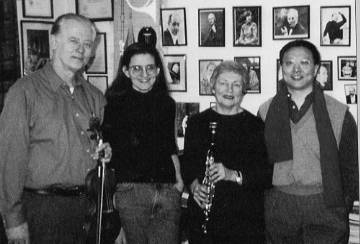|
<< -- 2 -- Peter Dickinson PERSUASIVE INFLUENCE

A new work by Jonathan Harvey is always a special event. In the pre-concert discussion he mentioned that his Clarinet Trio (2005) developed from ideas about precisely ordered tempi in Stockhausen and Babbitt. This sounded somewhat intimidating compared with the seductive sounds of his recent pieces, some involving electronics. In the event Harvey also took an idea from Cage -- the song with closed piano accompaniment, The Wonderful Widow of Eighteen Springs (1942) -- by having the pianist play exclusively on the closed piano lid in the outer portions of the work. This was tough on the pianist's knuckles -- the Cage piece is much shorter -- when some kind of simple drum might have made the same effect. But Harvey seemed concerned that a grand piano could easily overwhelm the violin and clarinet so this was one way of keeping the piano in check. Then came Rainwaves (1997) by Joan Tower, another prominent American, whose Fanfare for the Uncommon Woman has been played by over 200 different ensembles. There were evocative watery effects based on wave patterns but two thirds of the way through the impetus collapsed with tentative ideas.

The Verdehr Trio with composer Bright Sheng
|
After the interval Wolfgang Rihm's Gesangstuck (2003) lasted for a sprawling half hour. Rihm studied under Stockhausen and taught at Darmstadt but in this work is a reformed character. Gesangstuck is in the tradition of Berg, even Mahler, but lacking their harmonic direction. Verdehr told us that the work had some fifteen sections which succeeded each other without a break but this was hard to follow and, although the performers made the most of it, the work was simply too long. Bright Sheng is another American with a major reputation -- his many tributes and commissions climaxed recently with the lavish MacArthur Award. Now almost 50, he was born in China and moved to the US in 1982. His Tibetan Dance (2000) is in three movements with the main emphasis falling in the longer last movement based on a Tibetan folk-dance. This is another demanding allegro -- delivered with enormous panache. The encore was Promenade from Gershwin's Shall we Dance (1936) -- deliciously swung too.
Continue >>
Copyright © 8 November 2005
Peter Dickinson, Suffolk UK

|

